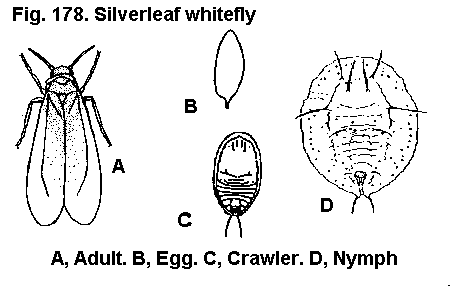 Fig. 178: Silverleaf Whitefly, Bemisia
argentifolii Bellows and Perring, Aleyrodidae, HOMOPTERA
A, Adult. B, Egg. C,Crawler. D, Nymph.
Fig. 178: Silverleaf Whitefly, Bemisia
argentifolii Bellows and Perring, Aleyrodidae, HOMOPTERA
A, Adult. B, Egg. C,Crawler. D, Nymph.
Silverleaf Whitefly: Thoracic tracheal folds relatively narrow, wax at marginal opening of tracheal folds relatively narrow, the posterior wax no wider than the bases of the caudal setae, fourth anterior submarginal setae absent; causes white stem symptom on poinsettia and silverleaf on squash.
Sweetpotato Whitefly: The description is slightly different from the silverleaf whitefly. (picture not available at this time) Thoracic tracheal folds relatively wide, wax at marginal opening of tracheal folds relatively wide, the posterior wax no wider than the bases of the caudal setae, fourth anterior submarginal setae present; does not cause white stem symptom on poinsettia nor silverleaf on squash.
Adult- The silverleaf whitefly is slightly smaller (about 0.96 mm in the female and 0.82 mm in the male) and slightly yellower than most other whitefly pests of flowers. The head is broad at the antennae and narrow towards the mouth parts. The wings are held roof-like at about a 45° angle, whereas other whiteflies usually hold the wings nearly flat over the body. Hence, the silverleaf whitefly appears more slender than other common whiteflies.
Egg- The eggs are inserted on end in the undersides of new leaves. The eggs are whitish to light beige with the apex tending to be slightly darker.
Nymph- The nymphal stages appear glassy to opaque yellowish and may or may not have dorsal spines, depending on leaf characteristics. The body is flattened and scale-like with the margin relatively near the leaf surface. There is not a marginal palisade of waxy spines.
Pupa- The pupa or fourth nymphal instar will be somewhat darker beigeish yellow and opaque, length is 0.6 to 0.8 mm. Pupae are relatively more plump compared to previous nymphal stages. The apex of anterior and caudal spiracular furrows have smalls amount of white wax deposits. The caudal setae are prominent, and the caudal end is somewhat acute. Dorsal spines are present when the host leaf is hairy and absent when the host leaf is smooth.
 Fig. 178: Silverleaf Whitefly, Bemisia
argentifolii Bellows and Perring, Aleyrodidae, HOMOPTERA
A, Adult. B, Egg. C,Crawler. D, Nymph.
Fig. 178: Silverleaf Whitefly, Bemisia
argentifolii Bellows and Perring, Aleyrodidae, HOMOPTERA
A, Adult. B, Egg. C,Crawler. D, Nymph.
Distribution- Silverleaf whitefly probably occurs around the world in tropical and subtropical areas and in greenhouses in temperate areas. It has been reported from California and Florida, and it occurs in North Carolina.
Host Plants- Alfalfa, beans, brocolli, Citrus, Ficus, Lantana, lettuce, melons, cotton, grape, sweet potato, and poinsettia are definite hosts of the silverleaf whitefly. Gerbera daisies are probably hosts.
Damage- Direct damage is caused by the removal of sap, and indirect damage as a disease vector. The silverleaf whitefly is a vector for several important virus diseases of lettuce and melons in the southwestern United States. Both the adult and nymphal stages contribute to direct damage. Chlorotic spots sometimes appear at the feeding sites on leaves, and heavy infestations cause leaves of cucurbits and stems of poinsettias to blanch ("silver") and wilt. The excretion of honeydew and the subsequent development of sooty mold fungi also reduces the appearance of the plant and its ability to photosynthesis and perform other physiological functions. Even though the silverleaf whitefly is considered an economic pest, economic thresholds have not been generated for this pest on ornamental plants.
Life History- (The following information was observed with whiteflies that were undoubtedly silverleaf whiteflies although at the time they were thought to be sweetpotato whiteflies.) Developmental times from egg deposition to adult emergence appear to be primarily controlled by temperature, humidity, and host plant. These times will vary from 16 to 38 days depending on these factors. The number of eggs laid by each female over her lifetime varies considerably, but appears to be around 80 to 100. There have been reports (in Israel) that repeated applications of insecticides have produced a highly fecund (300 eggs/females) strain of silverleaf whitefly. Apparently, at temperatures above 36°C eggs fail to hatch. "Crawlers" hatch from the eggs and crawl about until they insert threadlike mouthparts into the underside of the leaf to feed. They tuck their legs and antennae underneath and settle down closely to the leaf surface.
Crawlers molt into scalelike nymphs that also suck out sap. Nymphs molt a second and third time. The fourth stage eventually becomes a nonfeeding pupa. The adult whitefly develops within the pupa. Adults emerge from the pupa through a T-shaped slit about a month from the time the egg was laid. Females live about two weeks.
Control of silverleaf whiteflies is difficult because the eggs and older immature forms are resistant to many aerosol and insecticide sprays (in addition, the adults are extremely resistant to dry pesticide residue). For good control, the pesticide mixture must be directed to the lower leaf surface where all stages of the whiteflies naturally occur. One must make regular applications of pesticides to control crawlers and second stage nymphs until the last of a whole generation of immature whiteflies has hatched. However, some of the pyrethroid pesticides are somewhat more effective and need not be applied as often. Neem seed extract is not as acutely toxic as some of the synthetic pesticides, but has the advantage of being toxic to young nymphs, inhibiting growth and development of older nymphs, and reducing oviposition by adults. For specific chemical control recommendations, see your Cooperative Extension publications on ornamental plant pests.
University of Florida/IFAS Reference to Pest Control Guides